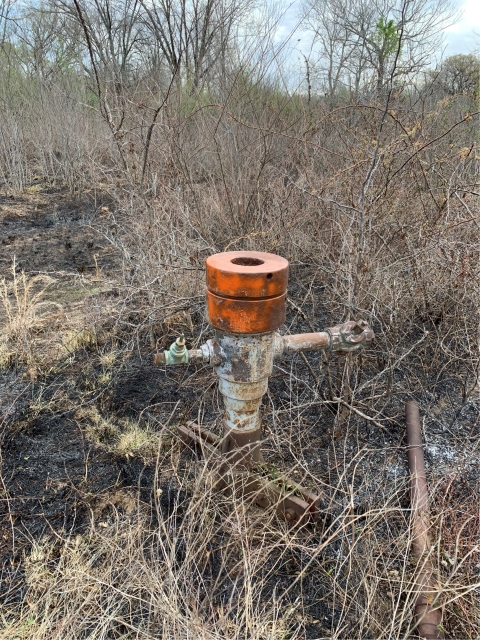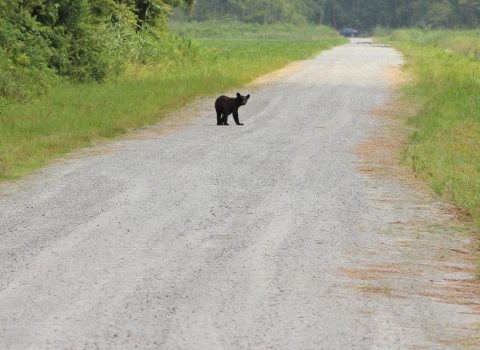Deep Fork National Wildlife Refuge was established in 1993 on land with a long history of industry, the marks from which are still visible on the landscape today. Railroad ties can be found in the shallow hollows where coal mine railroad beds once sat. Pecan tree orchards have blended into the forest, only discernable from the unnaturally straight lines of trees. But Orphan Wells, remnants of oil and gas extraction, are a scar left on the landscape that has not been allowed to heal. Now with funding from the Bipartisan Infrastructure Law Bipartisan Infrastructure Law
The Bipartisan Infrastructure Law (BIL) is a once-in-a-generation investment in the nation’s infrastructure and economic competitiveness. We were directly appropriated $455 million over five years in BIL funds for programs related to the President’s America the Beautiful initiative.
Learn more about Bipartisan Infrastructure Law , this persistent problem is finally being addressed.
“Orphan wells” are abandoned oil and gas infrastructure. These wells are no longer operational, and don’t have a viable operator on record. Without a viable operator, there is no longer a party responsible for their upkeep and maintenance. In a state of disrepair, they can leak hydrocarbons, methane, and contaminated brine, posing a threat to human health and to the environment. According to a report by the Interstate Oil & Gas Compact Commission, Oklahoma has an estimated 123,772 orphaned wells.
The problem at Deep Fork
The problem of orphan wells spreads across Deep Fork National Wildlife Refuge. There are ongoing efforts to locate, analyze, and categorize wells. So far, 217 suspected well sites have been surveyed, with another 350 on the way.
Orphan wells represent an ongoing hurdle to the conservation of the remnant bottomland hard wood forests and wetlands that Deep Fork NWR was founded to protect. These habitats are havens for migratory birds and native wetland and aquatic species, so Refuge Manager Todd Gallion is eager to address the issue.
“Orphan wells have been a persistent problem for the refuge. Their presence is holding us back from cleaning up old contaminant sites and returning habitats to their natural state,” Todd Said. “Capping these wells will benefit native species, and improve hunting, fishing and wildlife viewing for visitors to the refuge. Basically, addressing this problem means that we can reclaim the land for everyone’s benefit.”
Addressing the problem
Orphan well capping is a process by which the wells are plugged, preventing future contamination, and then cut off and capped beneath the ground. This allows for the area to be cleaned up and reclaimed for conservation. In fiscal year 2022, Deep Fork received funding to cap 24 wells through the Bipartisan Infrastructure Law. With the last stages of preparation being finalized now, capping is expected to start in late summer or early fall.
Outside of the direct benefits to wildlife, capping orphan wells will improve human safety and remove a source of environmental pollution from the landscape. Orphan wells are known to leak methane, a potent greenhouse gas that is 25 times better at trapping heat than carbon dioxide. Rusted and dangerous surface equipment often surrounds these wells, risking injury to people and wildlife. Many also leak brine and hydrocarbons , which can degrade water quality, potentially impacting downstream communities.
“We want to make sure that we care for and protect the watershed by removing any known and potential contaminant sources and restoring bottomland hardwood habitats, including wetlands,” Todd said. "These restored habitats can provide ecosystem service, like being water filters to the landscape, improving water quality for communities downstream. Addressing orphan wells is a vital part of that mission.”
Looking to the future
While this year’s capping efforts are still underway, Deep Fork NWR is already looking ahead to next year. On June 8th, U.S. Secretary of the Interior Deb Haaland announced fiscal year 2023 funding for Legacy Pollution Clean-Up. Deep Fork will receive funding to cap an additional 45 orphan wells. These wells were identified, categorized, and prioritized with the help of the Oklahoma Corporation Commission. “Without their cooperation we wouldn’t be where we are today,” Todd adds.
Of the newly funded capping projects, 32 are in upland habitat, while the other 13 will occur in the floodplain of the Deep Fork River. Todd is optimistic that with lessons learned this year, they are well prepared to take on more in the future.





